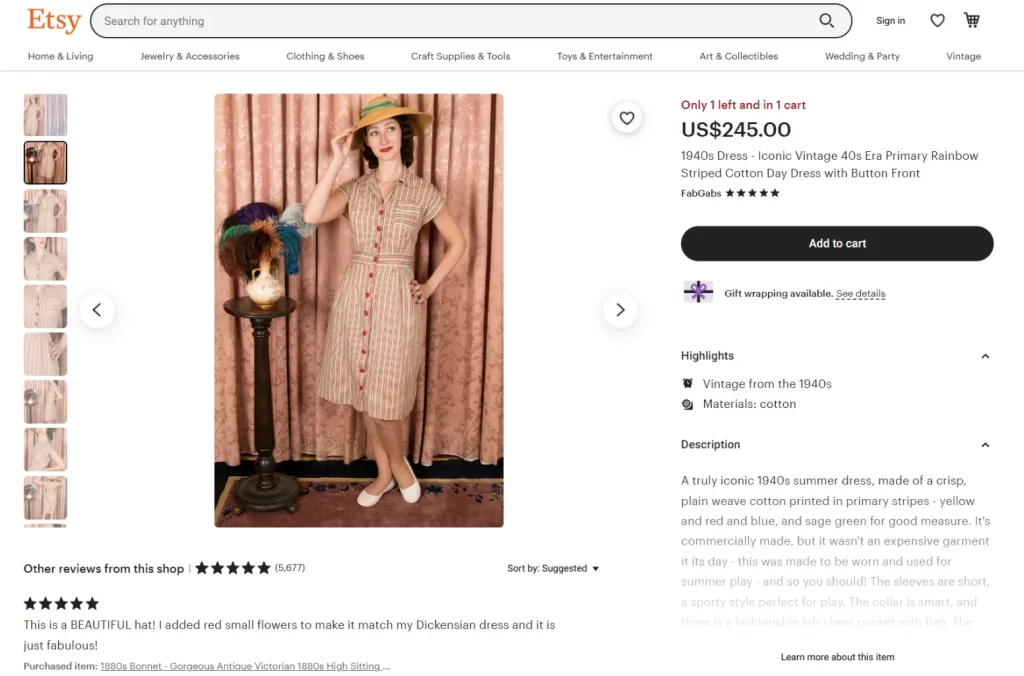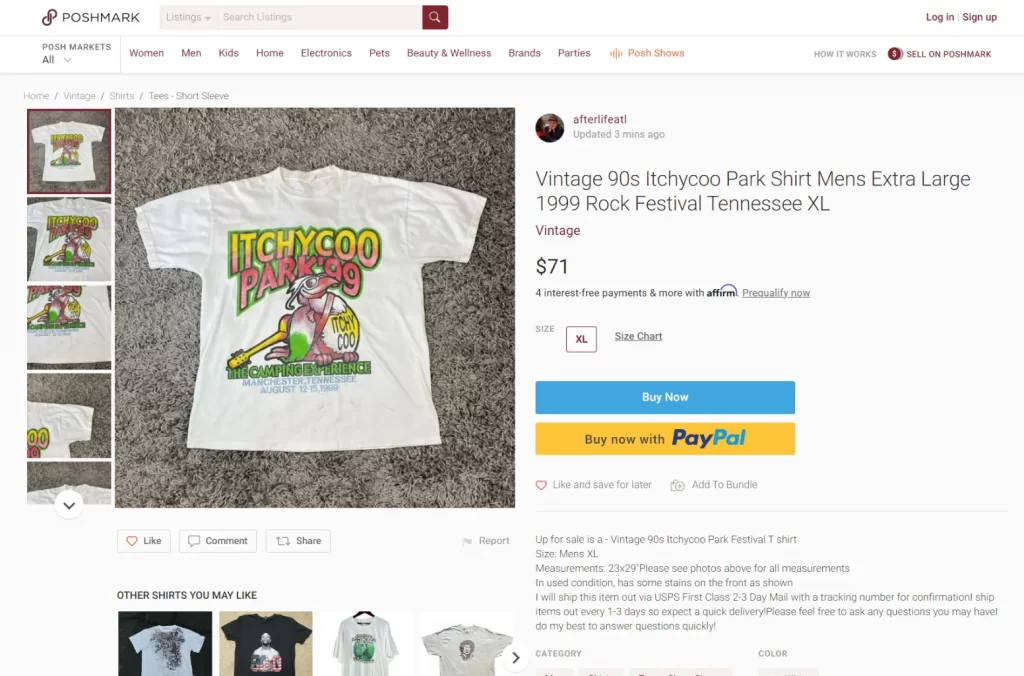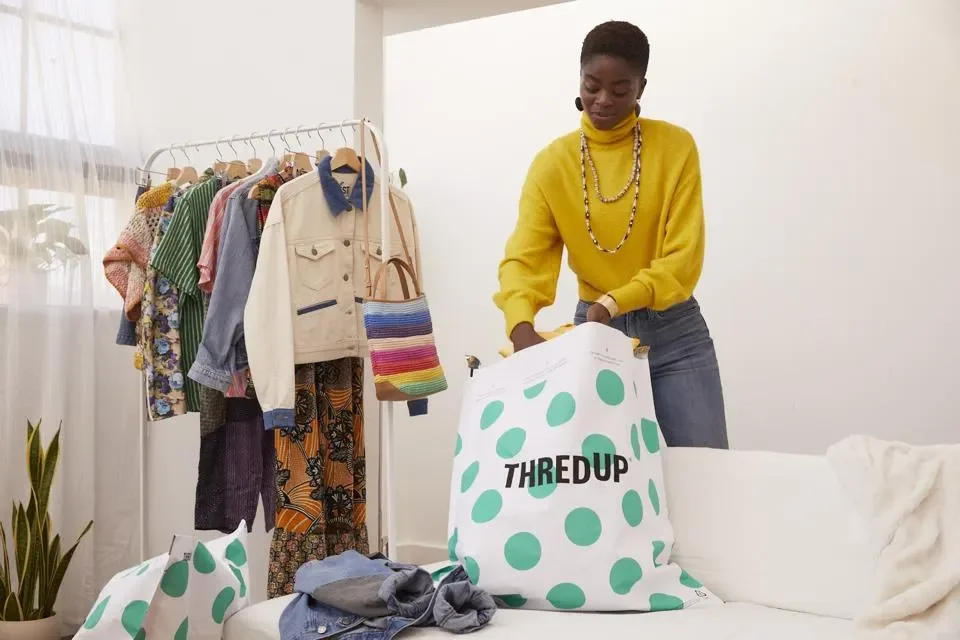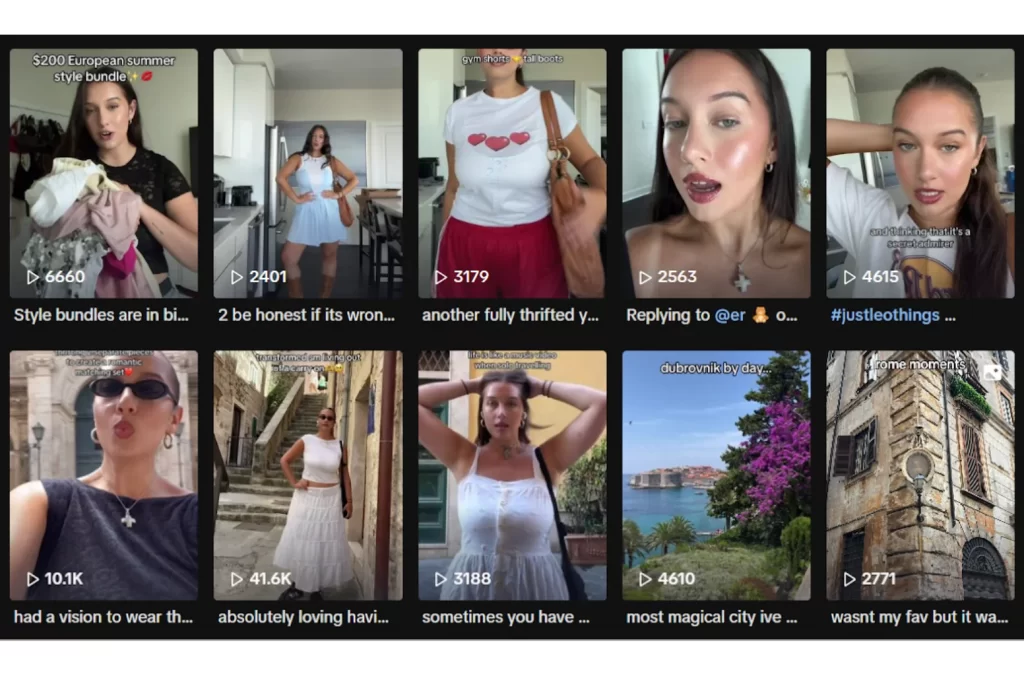Vintage clothing is all about discovery, finding pieces with history, character, and a story to tell. In 2026, the real hunt isn’t just for clothes but for the right marketplace. If you’ve been wondering where to sell vintage clothing, the answer lies in choosing the right platform
In this post, let’s discover the 9 best places to sell vintage clothing.
Without further ado, let’s get started!
Quick Summary
- Editor’s Choice: eBay – Biggest online marketplace, easy to sell almost anything. Flexible selling with auctions or fixed prices.
- Best for Handmade & Vintage: Etsy – Perfect for authentic vintage (20+ years old), curated shops, and unique handmade clothing.
- Best for Fashion Resale: Poshmark – Simple app to sell secondhand clothes and shoes. Sellers who enjoy engaging with buyers and community interaction.
- Best for Gen Z Style: Depop – Popular among Gen Z and Millennials for trendy, streetwear-inspired, and upcycled vintage fashion.
- Best for Consignment: ThredUp – Hands-off selling where the platform handles photos, pricing, and shipping. Ideal for large volumes of women’s and children’s clothing.
- Best Value: Vinted – Zero seller fees, with buyers covering service costs. Simple to use and especially strong in Europe, perfect for casual sellers.
- Best for Visual Selling: Instagram – Perfect for sellers focused on branding, storytelling, and community building, who want to show products with photos.
- Best for Viral Sales: TikTok – Short-form videos and trends help vintage sellers go viral. Great for video-savvy sellers targeting Gen Z.
- Best for Local & Social: Facebook – Reach massive audiences via Marketplace, Shops, and groups. Best for sellers using ads to target niche buyers or connect with local vintage communities.
Ready to Start Selling Vintage Clothing?
LitCommerce helps you list and sync your vintage pieces across platforms like eBay, Etsy, TikTok, and more!
Where to Sell Vintage Clothing Online? – 9 Best Places
Now, let’s explore where to sell clothing on various platforms below.
1. eBay

Launched in 1995, eBay is one of the biggest online marketplaces in the world. It started with an auction for a broken laser pointer and has since become a trusted place for buying and selling secondhand goods, including vintage items. eBay even has a special category for vintage clothing, shoes, and accessories, so buyers can easily find what they want.
eBay is also flexible because it offers two ways of listing, including auctions and fixed prices. You can choose an auction-style listing, which creates excitement and competition for rare or unique pieces, or you can use the “Buy It Now” option if you prefer to set a fixed price for faster sales.
Selling Fees
- No listing fee if you have fewer than 250 listings per month.
- Final value fee is 15% per item if the total sale amount is $2,000 or less; it drops to 9% per item if the total sale exceeds $2,000.
- Fixed per order fee: $0.30 for orders $10.00 or less, and $0.40 for orders over $10.00.
Pros
- Global reach with millions of buyers.
- Auction or “Buy It Now” gives sellers flexibility.
- Good buyer trust thanks to strong protections.
Excellent for high-value vintage or niche collectors’ items.
Cons
- High competition means strong photos/descriptions are a must.
- High eBay selling fees
- Returns and disputes can be time-consuming.
Best For:
2. Etsy

Etsy is an online marketplace well known for handmade and vintage items, with 87.3 million active buyers. To be considered vintage on Etsy, an item must be at least 20 years old, so buyers know they are getting something authentic.
For anyone researching where to sell vintage clothing, Etsy stands out because this platform is also highly visual, allowing sellers to create a branded shop and develop a consistent aesthetic that attracts loyal customers.
However, Etsy enforces strict rules on authenticity. Sellers cannot simply claim items as vintage based on inheritance, other listings, or purchases from estate or yard sales without proper proof. They may require additional details or documentation to verify vintage status.
Selling fees:
- One-time set-up fee from $15 to $29
- $0.20 listing fee per item (valid for 4 months)
- 6.5% transaction fee on sale price (including shipping)
- 3% + $0.25 payment processing fee
- Optional fees for ads and additional services
Pros:
- Access to a large audience looking for vintage and handmade items.
- Attracts serious buyers willing to pay a premium for genuine vintage items.
- Easy setup and listing process with support for shop branding.
- Strong community of vintage and sustainable fashion enthusiasts.
- Lower fees than eBay
Cons:
- Strict rules on what qualifies as “vintage”
- Limited brand control and reliance on Etsy’s policies.
Best for: Creative sellers with curated, unique, or handmade vintage clothing (20+ years old) who want to target a niche, aesthetically-driven audience, and strong branding and storytelling.
If you’re new to Etsy, check out our step-by-step guide: How to Sell on Etsy for Beginners in 2026 to learn everything you need to set up your shop and start selling successfully.
3. Poshmark
Besides eBay and Etsy, Poshmark is another online vintage marketplace with over 80 million monthly users for resellers to start their reselling business from scratch.
Poshmark is a fashion resale app that works like a mix of shopping and social media, creating community-driven resale experiences for new and secondhand fashion, home goods, and electronics.
This platform allows sellers and buyers to like, comment, or share the product before buying it. This feature, for sure, is an excellent plus score for vintage buyers if they want to ask for any more information about the items, negotiate prices, and more.

Selling fees:
- No listing fee
- $2.95 flat fee for sales under $15
- 20% commission fee for sales $15 or more (includes shipping)
Pros:
- Large, engaged community of fashion-focused buyers, especially women.
- Social marketplace that promotes interaction, sharing, and following, helping boost visibility and sales
- Simple listing process via mobile app, including prepaid shipping labels
- Supports bundling, allowing sellers to sell multiple items in one sale, reducing shipping costs
Cons:
- Higher selling fees compared to Etsy or Vinted.
- Listing visibility often requires consistent sharing and engagement
Best for:
4. ThredUp
ThredUp is born to answer the question, “Where to sell vintage women’s clothing?”. This place only accepts and sells women’s and children’s clothing.

ThredUp is one of the easiest platforms for selling secondhand clothes because it does most of the work for you. Besides eBay or Poshmark, ThredUp offers a different approach.
Instead of creating your own listings, you simply send your clothes in a ‘Clean Out Kit,’ and the company handles photos, pricing, and shipping, making it one of the easiest options for anyone exploring where to sell vintage clothing online.
Selling fees:
- No listing fees or upfront costs for branded shops.
- $14.99 fee (for standard bags) or a $34.99 fee (for premium bags) per 30 lb-capacity clean-out kit
Pros:
- Hands-off, consignment-style selling
- No upfront or monthly fees for branded resale shops as of 2025.
- Integration with cleaning and repair services to enhance item quality
- If no one buys an item, you can reclaim it or leave it to ThredUp
Cons
- Limited to women’s and children’s clothing.
- Sellers have less control over pricing and marketing.
- Not ideal for sellers wanting quick turnover or control.
Best for: Sellers who prefer a low-effort consignment model and have a large volume of vintage clothing, who prioritize convenience over maximizing profit.
5. Vinted
While searching for “Where can I sell vintage clothing online?”, Vinted may appear as the best deal for sellers, as there is no commission or listing fee on this platform.
Vinted handles the buyer-paid shipping label, and sellers receive their earnings once the buyer confirms receipt of the goods. The buyer then pays for postage and an additional Buyer Protection fee.
This platform is especially well-known in Europe but is also available to users in the U.S. One notable feature of this platform is that buyers can make an offer to negotiate prices with you by using the “Make an offer” button.
Selling fees
- No fees for sellers
- A fixed amount of $0.70
- 5% of the item price agreed to between the Buyer and the Seller, not including the shipping costs, any additional costs, and applicable taxes.
Pros
- No selling fees for sellers; buyers pay a service fee.
- Easy-to-use app with strong community and buyer protection.
- Seller controls pricing and can negotiate with buyers.
- Large user base, especially in Europe, and growing in other regions.
Cons
Some reports of inconsistent customer service.
Best for: Casual sellers, individual sellers looking for low-cost entry, and those with preloved vintage clothes, not focused on brand building or high volume.
6. Depop
Looking beyond traditional marketplaces, Depop is a fresh, social-driven option for anyone wondering where to sell vintage clothing and connect with younger, trend-conscious buyers.
Like Poshmark, the Depop marketplace is a social shopping app allowing sellers and customers to engage in peer-to-peer exchanges and interactions.
This platform enables users to buy and sell clothing, especially vintage, unique, and upcycled fashion, through a vibrant community-driven platform. Sellers create personalized storefronts and engage directly with followers, blending commerce with creativity and social interaction.
Depop is popular with Gen Z and millennials who value sustainable fashion and unique items. It evolved into one of the top resale marketplaces by eliminating commission fees and focusing on individual creators and sellers with a mobile-first, influencer-driven approach.
Selling fees:
UK & US Sellers:
- No Depop selling fee when buyers use the “BUY” button.
- Payment processing fees:
- UK: 2.9% + £0.30 per transaction
- US: 3.3% + $0.45 per transaction
- Fees apply to item price + shipping + taxes.
Sellers Outside UK & US:
- 10% Depop selling fee on each sale (item price only, if the Depop label is not used).
- Payment processing fees vary by country (e.g., AU: 2.6% + $0.30 AUD).
- PayPal fees may apply depending on location and setup.
Pros:
- Social shopping platform is great for building a personal brand and following.
- Popular with young, trendy, vintage, and unique fashion buyers.
- Flexible pricing and strong creative freedom for sellers.
Cons:
- Poor customer service
- Some sellers report issues with scammers and refund disputes.
Best for: Creative sellers targeting Gen Z and young adults, those selling trendy, vintage, or niche fashion items who want to build a brand and engage actively with buyers on a social platform.
7. Instagram
As a visual platform, Instagram is a powerful tool for showcasing high-quality product images, making it one of the best places to sell vintage clothing online. You can use all Instagram tools like posts, stories, reels, and live videos to show off your vintage items and create engaging content, such as ideas for mixing and matching them.
Instagram demographics show an audience that is almost equally split between males (50.6%) and females (49.4%), with the largest user groups being 18-24 year olds (31.7%) and 25-34 year olds (30.6%) globally, making the platform heavily favored by Gen Z and Millennials. Key users are also found in high-income brackets, particularly in the U.S.
Additionally, Instagram Shopping allows customers to browse or buy items from your eCommerce store easily. If you don’t have a store on the eCommerce platforms, you can choose DMs as a checkout option on Instagram. This makes the buying process easier for the customers.

Selling fees
- No listing fee
- A processing fee for sales made through their in-app Checkout method: Flat fee of $0.40 for items $8.00 or less, or 5% for items over $8.00, per shipment or transaction.
- Ads cost extra (optional)
Pros
- Highly visual platform ideal for showcasing well-photographed vintage clothing.
- Multiple content formats (posts, stories, reels, live) for engaging storytelling and styling ideas.
- Integrated shopping features allow direct purchases or checkouts via DMs.
- Access to a large, diverse audience interested in fashion and trends.
- Strong tools for brand building and influencer marketing.
Cons
- Highly competitive with many sellers vying for attention.
- Requires regular content creation and engagement.
Best for: Sellers who want to build a brand around vintage fashion, engage with a community, and market through visuals and stories.
8. TikTok
Where to sell vintage clothing? With 47.4% of TikTok users under 30, TikTok is a great place to sell vintage, especially when the young generations are the most interested in it.
As a short video platform, TikTok offers a great way to showcase your vintage ware and directly generate clients through content. Additionally, a viral video can reach hundreds of thousands of people, who might be converted into your actual customers.
Furthermore, using a TikTok business account, you can set up a TikTok Shop featuring tools like in-app shopping, a product showcase tab, affiliate partnerships, ad integration, and more. These features create a fast and seamless buying experience for customers without leaving the app.

Selling fees
- No listing fees
- 6% referral fee on sales (apparel category)
- 2.18% transaction fee + $0.30/order
- Fulfillment program (FBT) fees $3.58/item + storage fees if used
Pros
- Explosive reach, especially among younger audiences.
- Short-form video format is excellent for showcasing vintage clothing in creative, entertaining ways.
- Algorithm favors discovery, making it easier to go viral.
- Trends and challenges can boost visibility rapidly.
Cons
- Requires constant creative content and video editing skills.
- TikTok’s audience tends to focus on fast trends rather than curated vintage collections.
Best for: Sellers who enjoy video creation, want to tap into viral marketing, and reach Gen Z and millennial vintage buyers.
Showcase Your Vintage Clothing on TikTok Shop!
Tap into TikTok’s massive audience and showcase your vintage clothing with ease. LitCommerce helps you quickly list and sync your products to TikTok Shop
9. Facebook
Lastly, we can’t ignore Facebook – The world’s top 1 social site. With an average of 3.7 billion users, this is a significant platform for reaching potential buyers interested in vintage fashion.
Like Instagram and TikTok, you can post photos of your product and relevant content on Facebook so that your fans can see them in their feeds. Moreover, targeted Facebook advertising allows your vintage store to reach more customers, and the Facebook group feature allows you to build a community around your vintage clothing offerings.
In addition, Facebook provides advanced ad targeting that allows businesses to reach buyers interested in vintage clothes. For selling, it offers both Facebook Marketplace and Facebook Shops, making the buying process simple and convenient.
Selling fees
- No listing fee
- A processing fee when using their integrated payment methods: Flat fee of $0.40 for items $8.00 or less, or 5% for items over $8.00, per shipment or transaction.
- Advertising on Instagram (optional)
Pros
- Massive global audience with detailed targeting capabilities.
- Variety of formats: Marketplace, groups, shops, live sales.
- Established trust and familiarity among older demographics.
- Ability to create dedicated pages and groups for vintage sellers.
- Robust advertising platform for precision marketing
Cons
- High competition.
- Organic reach has declined; paid ads are often necessary.
- The platform is aging, with some younger users migrating to other social sites.
Best for: Sellers targeting older vintage enthusiasts, those with existing customer bases, or sellers who want to use focused ads to reach a specific market.
Expand Your Vintage Clothing Reach!
With LitCommerce, you can easily list your vintage pieces from your online store to Instagram, TikTok, Facebook, and more – while syncing inventory and managing orders in one place.
Where to Sell Vintage Clothing – FAQs
The easiest way to sell vintage clothing is to list your vintage items on eBay. eBay can be considered a real OG for selling and buying vintage items. Thus, you can easily list items on this marketplace, from clothing to toys, at any price. You can set a fixed price with Buy It Now option or let people bid on the item with an eBay auction for a certain amount of time. Here are 9 best places to sell vintage clothing: Yes, it is. As there is a demand for vintage clothing, selling this fashion can be a lucrative business. Nowadays, vintage clothing is seen as a cheaper and more environmentally friendly option, attracting more customers, especially the young. There are two options for selling vintage clothes: online and offline. Some popular online platforms to sell vintage clothing are eBay, Etsy, Poshmark, thredUP, and Depop. Yes, vintage clothing is in demand. According to Statista, the global market value of vintage and resale clothing in 2022 was estimated to be worth 177 billion U.S. dollars. Moreover, this kind of clothing is seen as a cheaper and more environmentally friendly option, which especially attracts young consumers. To sell vintage clothing near you, a brick-and-mortar store is one of the recommendations. However, we also live in a digital world, so don’t forget to leverage the power of online marketplaces and social media platforms.
Turn Your Vintage Finds Into Profit Today!
Selling vintage clothing online opens up a world of possibilities to connect with buyers who appreciate a unique and sustainable lifestyle. In this guide, we’ve explored the best platforms for where to sell vintage clothing, from Etsy’s artisanal community to eBay’s global marketplace and Depop’s visual, trend-driven audience.
Our advice? Start small. Focus on two or three platforms first so you can learn their rules, build your presence, and maximize your results without spreading yourself too thin. Once you’ve mastered a few, you can expand to others.
For more tips on selling online, don’t forget to explore the Retailer blog or Contact us anytime with your questions.




